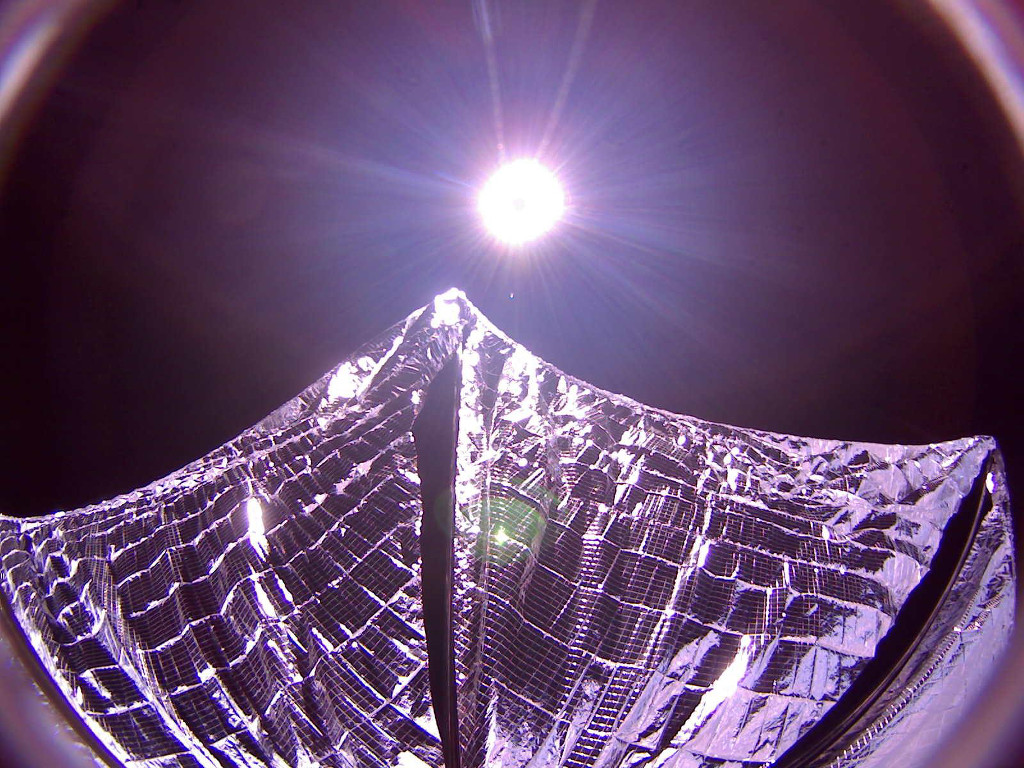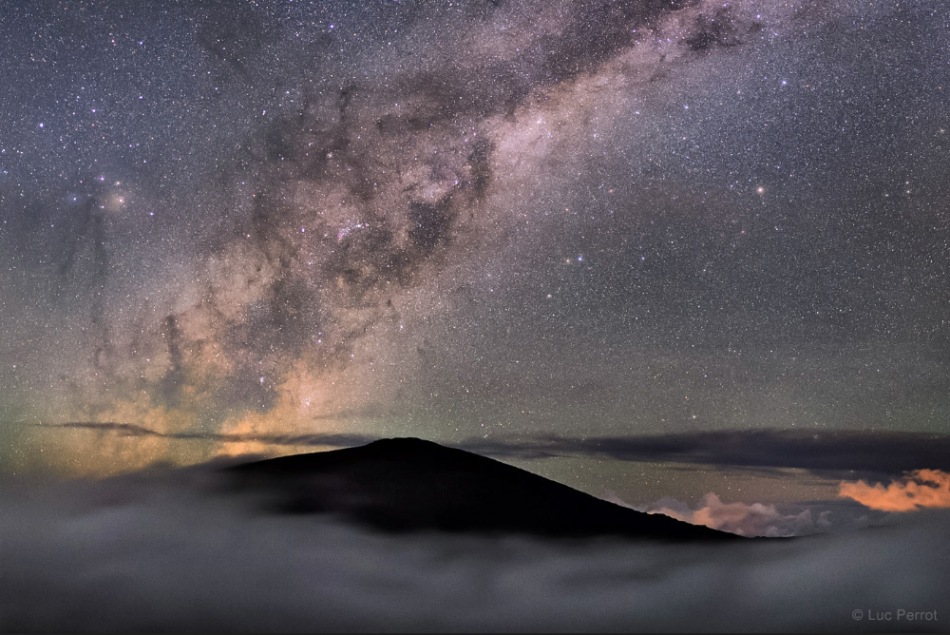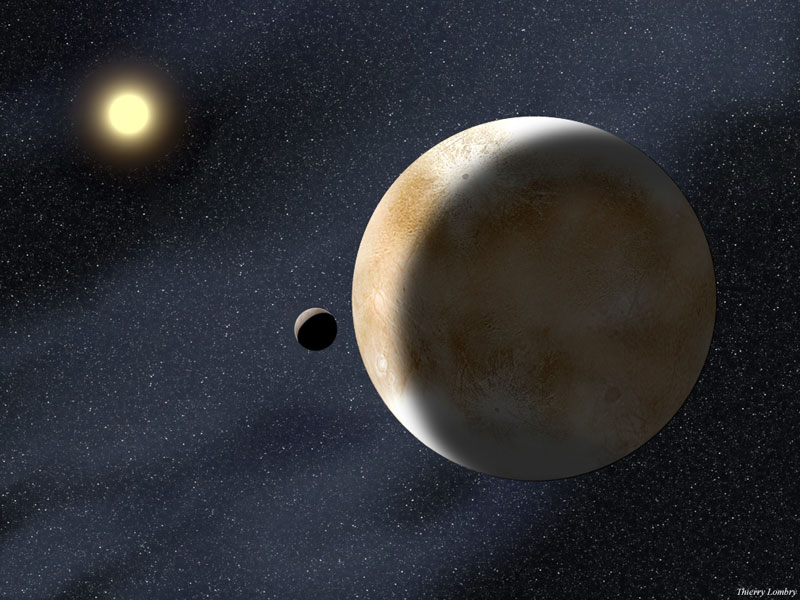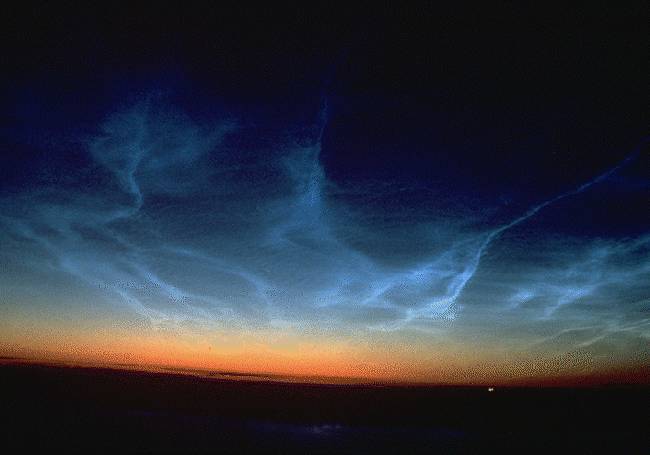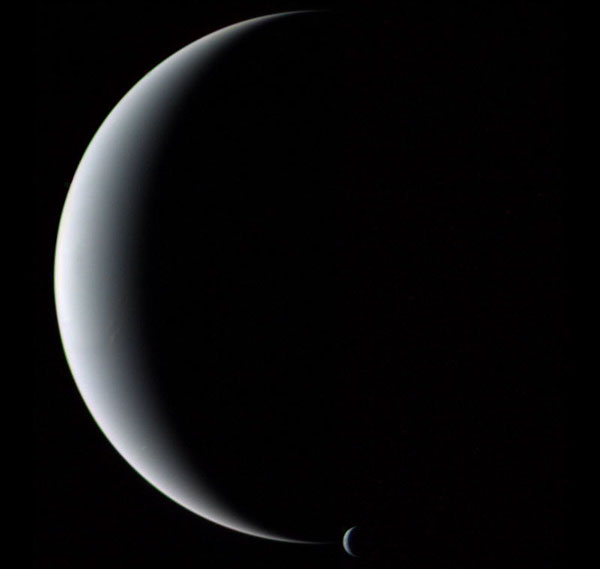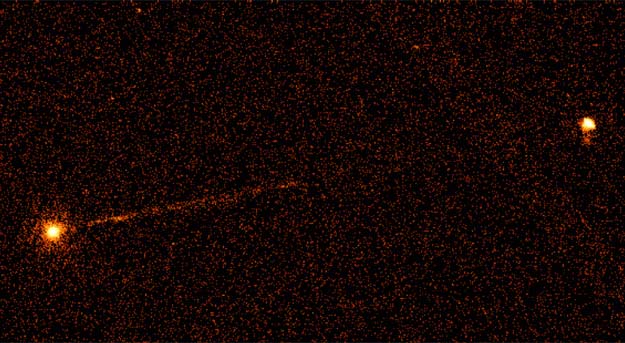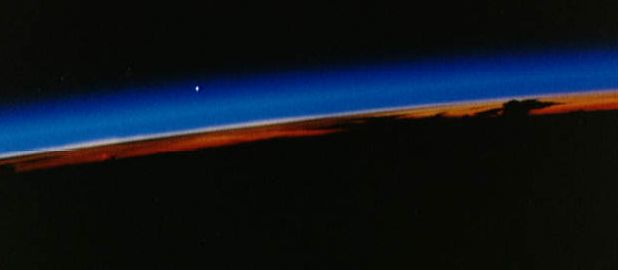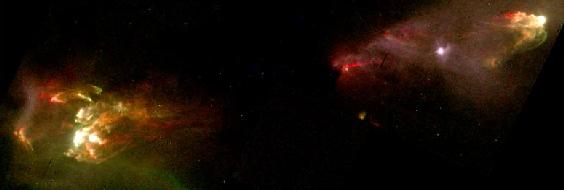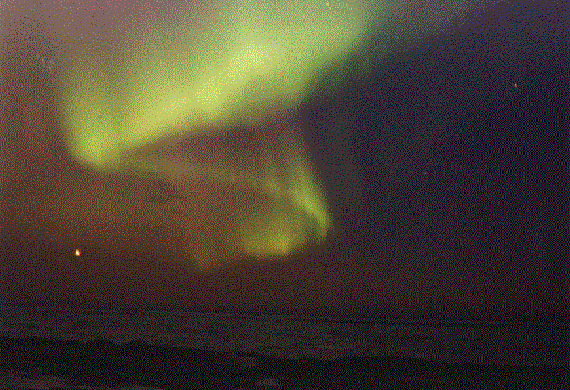| << Previous | Index | Next >> |
2015 Hitching a ride to low Earth orbit, LightSail A accomplished a challenging test mission, unfurling its 32 square meter mylar solar sail on June 7. This dramatic image from one of the bread loaf sized spacecraft's fisheye cameras captures the deployed sail glinting in sunlight. Sail out and visible to Earthbound observers before its final orbit, LightSail A reentered the atmosphere last weekend. Its succesful demonstration paves the way for the LightSail B spacecraft, scheduled for launch in April 2016. Once considered the stuff of science fiction, sailing through space was suggested 400 years ago by astronomer Johannes Kepler who observed comet tails blown by the solar wind. But modern solar sail designs, like the one tested by LightSail A rely on the small but continuous pressure from sunlight itself for thrust.
2014 The central bulge of our Milky Way Galaxy rises above a sea of clouds in this ethereal scene. An echo of the Milky Way's dark dust lanes, the volcanic peak in foreground silhouette is on France's Réunion Island in the southern Indian Ocean. Taken in February, the photograph was voted the winner of the 2014 International Earth and Sky Photo Contest's Beauty of the Night Sky Category. This and other winning and notable images from the contest were selected from over a thousand entries from 55 countries around planet Earth. Also featured in the contest compilation video (vimeo), the moving images are a testament to the importance and beauty of our world at night.
2013
[imghover6=http://apod.nasa.gov/apod/image/1306/mw ... re_960.jpg]http://apod.nasa.gov/apod/image/1306/mw ... ed_960.jpg[/imghover6]Image Credit & Copyright: John H. Moore; Annotation: Judy Schmidt
2012 What's left after a star explodes? To help find out, NASA launched the Nuclear Spectroscopic Telescope Array (NuSTAR) satellite into Earth orbit last week. NuSTAR's ability to focus hard X-rays emitted from the nuclei of atoms will be used, among other things, to inspect the surroundings of supernova remnants so as to better understand why these supernovas occurred, what types of objects resulted, and what mechanisms make their surroundings glow so hot. NuSTAR will also give humanity unprecedented looks at the hot corona of our Sun, hot gasses in clusters of galaxies, and the supermassive black hole in the center of our Galaxy. Pictured above is an artist's illustration depicting how NuSTAR works. X-rays similar to those used in your dentist's office enter the telescope on the right and skip off two sets of parallel mirrors that focus them onto the detectors on the left. A long but low-weight mast separates the two, and the whole thing is powered by solar panels on the upper left. Part of the excitement involving NuSTAR is not only what things it is expected to see, but by looking at the universe in a new way, what things that are completely unknown that might be discovered. NuSTAR has a planned two year lifetime.
2011 From fifty kilometers above asteroid Eros, the surface inside one of its largest craters appears covered with an unusual substance: regolith. The thickness and composition of the surface dust that is regolith remains a topic of much research. Much of the regolith on 433 Eros was probably created by numerous small impacts during its long history. In this representative-color view taken by the robot spacecraft NEAR-SHOEMAKER that orbited Eros in 2000 and 2001, brown areas indicate regolith that has been chemically altered by exposure to the solar wind during micrometeorite impacts. White areas are thought to have undergone relatively less exposure. The boulders visible inside the crater appear brown, indicating either that they are old enough to have a surface itself tanned by the solar wind, or that they have somehow become covered with some dark surface dust. This July, NASA's Dawn spacecraft will orbit giant main belt asteroid Vesta.
2010 Get out your red/blue glasses and float next to asteroid Itokawa, a diminutive world of the solar system only half a kilometer across. Boulders strewn across its rough surface and the lack of craters indicate that this asteroid is a rubble pile, formed as smaller pieces collected and were kept together by gravity. The stereo view was constructed from images made by the Hayabusa spacecraft when it encountered the asteroid in 2005. After a long journey, the spacecraft re-entered the atmosphere on June 13 over Australia, successfully parachuting a capsule to Earth. Hayabusa's capsule could contain a small sample of material from rubble pile asteroid Itokawa.
2009
2008
2007 Eris, a dwarf planet currently orbiting the Sun at about twice Pluto's distance, has been measured to have about 27 percent more mass than Pluto. The mass was calculated by timing the orbit of Eris' moon Dysnomia. Images taken with a ground-based Keck telescope, when combined with existing images taken by Hubble Space Telescope, show that Dysnomia has a nearly circular orbit lasting about 16 days. Cataloged as 2003 UB313 only a year ago, infrared images also showed previously that Eris is actually larger in diameter than Pluto. The plane of Eris' orbit is well out of the plane of the Solar System's planets. In the above drawing, a scientific artist has imagined Eris and Dysnomia orbiting our distant Sun. No space missions are currently planned to Eris, although the robotic New Horizons spacecraft bound for Pluto has recently passed Jupiter.
2006 The star on the upper left is so bright it is sometimes hard to notice the galaxy on the lower right. Both the star, Regulus, and the galaxy, Leo I, can be found within one degree of each other toward the constellation of Leo. Regulus is part of a multiple star system, with a close companion double star visible to the upper right of the young main sequence star. Leo I is a dwarf spheroidal galaxy in the Local Group of galaxies dominated by our Milky Way Galaxy and M31. Leo I is thought to be the most distant of the several known small satellite galaxies orbiting our Milky Way Galaxy. Regulus is located about 75 light years away, in contrast to Leo 1 which is located about 800,000 light years away.
2005 Sometimes it's night on the ground but day in the air. As the Earth rotates to eclipse the Sun, sunset rises up from the ground. Therefore, at sunset on the ground, sunlight still shines on clouds above. Under usual circumstances, a pretty sunset might be visible, but unusual noctilucent clouds float so high up they can be seen well after dark. Pictured above, a network of noctilucent clouds casts a colorful but eerie glow visible above the dark. Although noctilucent clouds are thought to be composed of small ice-coated particles, much remains unknown about them. Recent evidence indicates that at least some noctilucent clouds result from freezing water exhaust from Space Shuttles.
2004 This asteroid has a moon! The robot spacecraft Galileo destined to explore the Jovian system, encountered and photographed two asteroids during its long interplanetary voyage to Jupiter. The second asteroid it photographed, Ida, was discovered to have a moon which appears as a small dot to the right of Ida in this image from 1993. The tiny moon, named Dactyl, is about one mile across, while the potato shaped Ida measures about 36 miles long and 14 miles wide. Dactyl is the first moon of an asteroid ever discovered. The names Ida and Dactyl are from Greek mythology. Many other asteroids are now known to have moons.
2003 Along the northwestern reaches of the lunar near side, the Sinus Iridum or Bay of Rainbows appropriately lies at the edge of the Moon's smooth, dark Sea of Rains (Mare Imbrium). In this sketch of the lunar surface around the Bay of Rainbows, the sun shines from the left, illuminating the arcing wall of the lava-floored bay. The bay's Cape Heraclides, seen here at the top of the sunlit arc, has been historically depicted as a moon maiden whose hair streams behind her as she gazes sunward across the bay. In the original Moon race - the race to map the Moon - this moon maiden first appeared in telescope-based drawings of the lunar surface by astronomer Giovanni Cassini in 1679. Still gazing across the lunar bay, the moon maiden inspired this drawing by modern day astronomer, Lucy Whitehouse. Done when she was 14, her sketch of the intriguing feature was made from the countryside in northern England, aided by a telescope equipped with a digital imaging eyepiece and a small television screen.
2002 The Moon, fresh from a biting encounter with the Sun last week, appeared next to threaten Venus. The waxing Moon appeared to glide right past, however, just a few degrees away. Venus, of course, is much further away from the Earth than the Moon, so the passing was really just an angular illusion. Pictured above on June 13, a fading sunset finds the crescent Moon and Venus between clouds and above the city lights of Geneva, Switzerland.
2001 Gliding silently through the outer Solar System, the Voyager 2 spacecraft camera captured Neptune and Triton together in crescent phase in 1989. The above picture of the gas giant planet and its cloudy moon was taken from behind just after closest approach. It could not have been taken from Earth because Neptune never shows a crescent phase to sunward Earth. The unusual vantage point also robs Neptune of its familiar blue hue, as sunlight seen from here is scattered forward, and so is reddened like the setting Sun. Neptune is smaller but more massive than Uranus, has several dark rings, and emits more light than it receives from the Sun.
2000 A jet stretching nearly a million light years has been imaged emanating from galaxy Pictor A. The thin jet of electrons and protons shoots out at nearly light-speed likely from the vicinity of a large black hole at the galaxy center. At the left of the above image in X-rays is the radio galaxy Pictor A, known as a radio galaxy for its strong radio emission. At the far end of the jet on the right a hot spot glows as the intense particle beam bores through a gas cloud in intergalactic space. The jet and hot spot of Pictor A had been seen previously in radio waves, but only recently has the orbiting Chandra X-ray Observatory confirmed its unusual power.
1999 Venus can appear as a brilliant evening star. Besides the sun and moon, Venus is the brightest object visible in Earth's sky. Because it is closer to the sun than Earth, Venus never strays far from the sun in its apparent position and is seen during the year as either a bright morning or evening star. This beautiful sunset imaged from low earth orbit by the Atlantis space shuttle crew in May 1989 also reveals the planet Venus blazing above Earth's horizon. It is a fitting image for this mission and crew. It was recorded following the successful release of the robot Venus-explorer Magellan, the first planetary probe to be deployed from a space shuttle.
1998 Looking down on the Northern Hemisphere of Mars on June 1, the Mars Global Surveyor spacecraft's wide angle camera recorded this morning image of the red planet. Mars Global Surveyor's orbit is now oriented to view the planet's surface during the morning hours and the night/day shadow boundary or terminator arcs across the left side of the picture. Two large volcanos, Olympus Mons (left of center) and Ascraeus Mons (lower right) peer upward through seasonal haze and water-ice clouds of the Northern Martian Winter. The color image was synthesized from red and blue band pictures and only approximates a "true color" picture of Mars.
1997 A cloud of interstellar gas and dust collapses and a star is born. At its core temperatures rise, a nuclear furnace ignites, and a rotating dusty disk forms surrounding the newborn star. According to current understanding, as material continues to fall onto the disk it is heated and blasted back out along the disk's axis of rotation, forming a pair of high speed jets. This Hubble Space Telescope image shows two nebulosities at the ends of opposing jets from a young star. The bright blobs at either end are where the jet material has slammed into interstellar gas. Tip to tip, the distance is about one light-year. Located near the Orion Nebula, these nebulosities have catalog designations HH1 and HH2 for their discoverers astronomers George Herbig and Guillermo Haro. The nascent star which produced the jets is in the middle, hidden by a cloud of obscuring dust. Yet the structures and details visible in the star jets offer clues to events which also occured in our own Solar System - when the Sun was formed from a collapsing interstellar cloud 4.5 billion years ago.
1996 Looking out over Lake Superior at dusk you see Venus (lower left) and ... curtains? Like an ant looking up at window curtains, aurora frequently appear as huge flowing light displays. These colorful, often spectacular phenomena are most frequently visible from locations near the Earth's poles. Aurora are caused by electrons from the solar wind funneling to Earth along magnetic field lines, and striking atoms and molecules in our atmosphere. Auroral color is determined by which atmospheric ions are struck and recombine to form neutral atoms. Hourly updates of auroral sightings are posted to the WWW. It is still controversial whether aurora make any sound audible from the ground. If you think you have "heard an aurora," please report it!
| << Previous | Index | Next >> |
